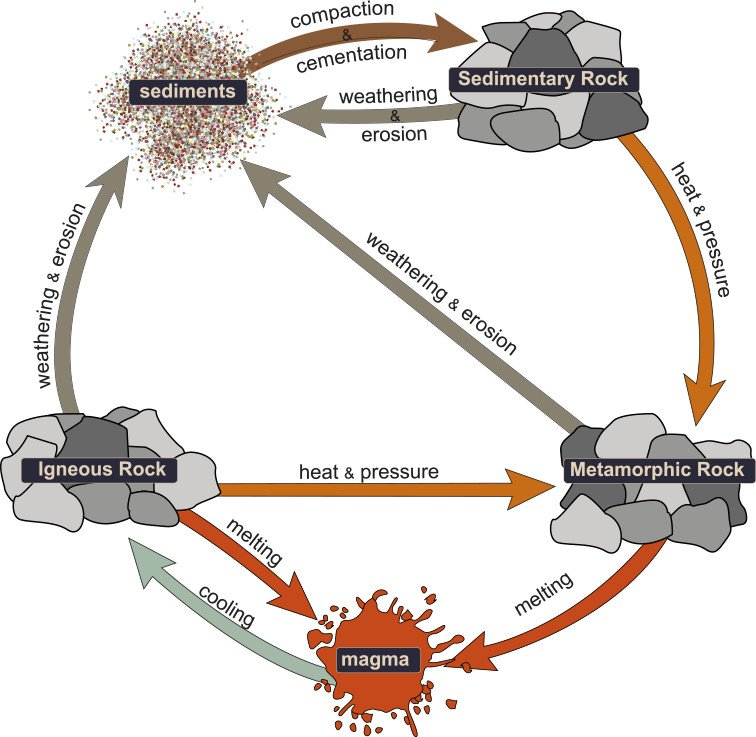
Draw the diagram of a Rock cycle and explain it.
Answer
547.5k+ views
Hint: Rock cycle is a process that creates and transforms the various types of rocks found in the earth's crust.
There are various types of physical changes like melting, cooling, deforming, compacting or eroding that occurs in the process of Rock formation.
Complete answer:

There are basically three types of rocks:-
1. Igneous rocks
2. Sedimentary rocks
3. Metamorphic rocks
Rock cycle steps :-
1. When magma cools down to a temperature where it can no longer remain in a liquid state it turns into igneous rocks.
2. When igneous rocks are subjected to the extreme natural conditions where the process of weathering and erosion takes place, these rocks change to form sediments.
3. These sediments remain compact and cementfies to form sedimentary rocks.
4. When sedimentary rocks come in contact with heat and pressure for a longer period, it changes its state to metamorphic rock.
5. When metamorphic rock is subjected under high temperature for a longer period, it melts to form magma.
6. Igneous rock will form metamorphic rocks when it comes under heat and pressure to alter and recrystallize in a continuous cycle.
7. When metamorphic rock will face weathering and erosion it will change its state to sediments.
8. Further, when igneous rocks will stay under high temperature where it no longer can continue its solid state it Melts to form Magma.
Note: A rock that cools down within the earth is called intrusive or Plutonic rock. It cools very slowly producing a coarse grained texture such as the Rock Granite.
There are various types of physical changes like melting, cooling, deforming, compacting or eroding that occurs in the process of Rock formation.
Complete answer:

There are basically three types of rocks:-
1. Igneous rocks
2. Sedimentary rocks
3. Metamorphic rocks
Rock cycle steps :-
1. When magma cools down to a temperature where it can no longer remain in a liquid state it turns into igneous rocks.
2. When igneous rocks are subjected to the extreme natural conditions where the process of weathering and erosion takes place, these rocks change to form sediments.
3. These sediments remain compact and cementfies to form sedimentary rocks.
4. When sedimentary rocks come in contact with heat and pressure for a longer period, it changes its state to metamorphic rock.
5. When metamorphic rock is subjected under high temperature for a longer period, it melts to form magma.
6. Igneous rock will form metamorphic rocks when it comes under heat and pressure to alter and recrystallize in a continuous cycle.
7. When metamorphic rock will face weathering and erosion it will change its state to sediments.
8. Further, when igneous rocks will stay under high temperature where it no longer can continue its solid state it Melts to form Magma.
Note: A rock that cools down within the earth is called intrusive or Plutonic rock. It cools very slowly producing a coarse grained texture such as the Rock Granite.
Recently Updated Pages
Two men on either side of the cliff 90m height observe class 10 maths CBSE

What happens to glucose which enters nephron along class 10 biology CBSE

Cutting of the Chinese melon means A The business and class 10 social science CBSE

Write a dialogue with at least ten utterances between class 10 english CBSE

Show an aquatic food chain using the following organisms class 10 biology CBSE

A circle is inscribed in an equilateral triangle and class 10 maths CBSE

Trending doubts
Why is there a time difference of about 5 hours between class 10 social science CBSE

Write a letter to the principal requesting him to grant class 10 english CBSE

What is the median of the first 10 natural numbers class 10 maths CBSE

The Equation xxx + 2 is Satisfied when x is Equal to Class 10 Maths

Which of the following does not have a fundamental class 10 physics CBSE

State and prove converse of BPT Basic Proportionality class 10 maths CBSE




